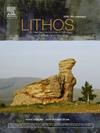从复合岩浆火山下方的管道系统中获得新启示:来自比利亚里卡岩浆的冰川期后挥发性成分和岩浆流体
IF 2.9
2区 地球科学
Q2 GEOCHEMISTRY & GEOPHYSICS
引用次数: 0
摘要
比利亚里卡火山位于安第斯山脉南部,是一座复合岩浆火山,其持续的开放式喷口活动被频繁的斯特劳博勒式/夏威夷式喷发和更罕见的高能(亚普林式)喷发所打断。在这里,我们通过分析橄榄石托管熔体和流体包裹体的成分,研究了维持这种活动的母体熔体的挥发性成分,以及爆发前岩浆的储存条件。我们主要研究了在 14.5-13.5 千年火山口坍塌事件后,从比利亚里卡山顶及其侧翼小爆发中心(MECs)喷发出的火成碎屑物质中夹杂的矿物质,这些矿物质形成了利坎燃烧斑岩。我们的微傅立叶变换红外光谱(Micro-FTIR)和SIMS测量结果表明,Pucón喷发记录的挥发物含量最高,为6.0 wt% H2O、1500 ppm CO2、1330 ppm S、1556 ppm Cl和2055 ppm F。其他侧翼喷发的结果表明,在区域火山活动中心(Los Nevados、Caburgua)喷发的富含二氧化碳的玄武质岩浆也有类似的深度(17-21 千米)来源。熔融包裹体结果还显示,深层上升的岩浆群在 1-5 千米深处暂时储存时,产生了分化和脱气程度更高的岩浆群,这些岩浆群维持了比利亚里卡十年之久的持续喷发-爆炸性喷发活动。在橄榄石(Fo75-88)的大量惰性气体中测量到的氦同位素比率(3He/4He;按大气校正后的 Rc/Ra)表明,母岩浆流体特征(Rc/Ra = 6.7-7.6;CO2/3He = 4.7-7.5E+08),而且这种原始气体信号在横向岩浆流体中被稀释(Rc/Ra < 6.5;CO2/3He = 1.4 × 10+9-3.1E+10)。本文章由计算机程序翻译,如有差异,请以英文原文为准。
New insights from plumbing system below composite mafic volcanoes: Post-glacial volatile contents and magmatic fluids from Villarrica magmas
Villarrica volcano, in the southern Andes, is a composite mafic volcano whose persistent open-vent activity is punctuated by frequent Strombolian/Hawaiian eruptions and, more rarely, by more energetic (sub-Plinian) events. Here, we investigate the volatile composition of the parental melts that sustain this activity, and the conditions of pre-eruptive magma storage, by characterizing the composition of olivine-hosted melt and fluid inclusions. We concentrate on inclusions entrapped in minerals from pyroclastic materials erupted from both Villarrica summit and from its flank Minor Eruptive Centers (MECs) post the 14.5–13.5 kyr caldera collapse event that formed the Licán ignimbrite. Our micro-FTIR and SIMS measurements indicate that the Pucón eruption records the highest volatile contents, with 6.0 wt% H2O, >1500 ppm CO2, 1330 ppm S, 1556 ppm Cl, and 2055 ppm F. These volatile contents imply a volatile-saturated magma originating from a depth of 14.4 to 17 km below Villarrica. Results for other flank eruptions highlight a similarly deep (17–21 km depth) source for basaltic CO2-rich mafic magmas erupted at regional MECs (Los Nevados, Caburgua). Melt inclusion results also reveal that deep rising mafic magma batches, when temporarily stored at 1–5 km depth, produce the more differentiated and degassed magma batches that sustain the decadal-old persistent effusive-explosive eruptive activity at Villarrica. Helium isotope ratios (3He/4He; Rc/Ra when corrected for atmosphere) measured in bulk noble gases from olivines (Fo75–88) indicate that the parental magmatic fluid signature (Rc/Ra = 6.7–7.6; CO2/3He = 4.7–7.5E+08) is only recorded during central paroxysmal sub-Plinian eruption, and that this primitive gas signal is diluted in lateral MECs (Rc/Ra < 6.5; CO2/3He = 1.4 × 10+9–3.1E+10).
求助全文
通过发布文献求助,成功后即可免费获取论文全文。
去求助
来源期刊

Lithos
地学-地球化学与地球物理
CiteScore
6.80
自引率
11.40%
发文量
286
审稿时长
3.5 months
期刊介绍:
Lithos publishes original research papers on the petrology, geochemistry and petrogenesis of igneous and metamorphic rocks. Papers on mineralogy/mineral physics related to petrology and petrogenetic problems are also welcomed.
 求助内容:
求助内容: 应助结果提醒方式:
应助结果提醒方式:


